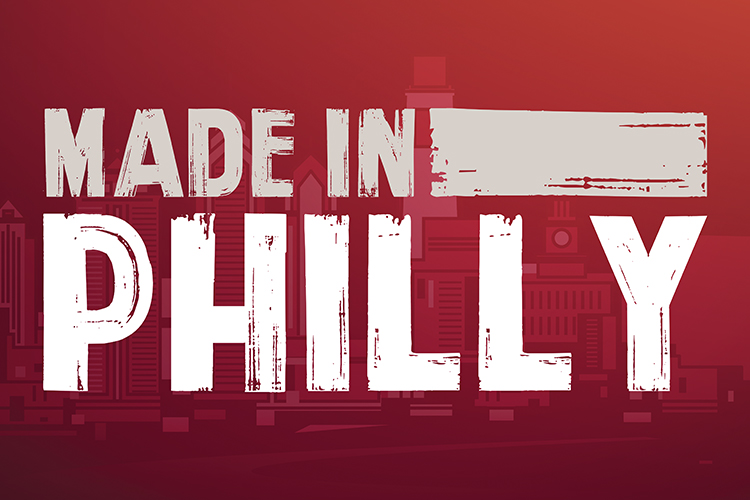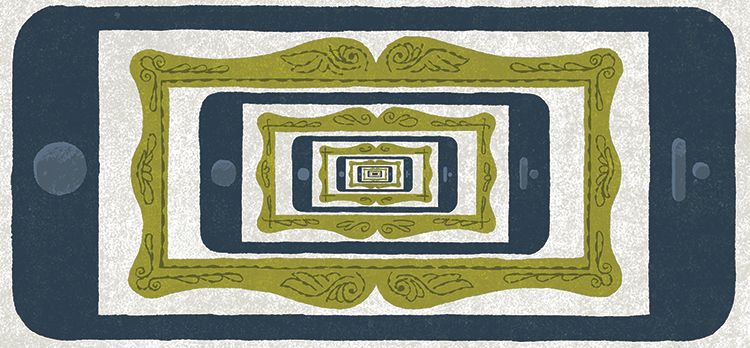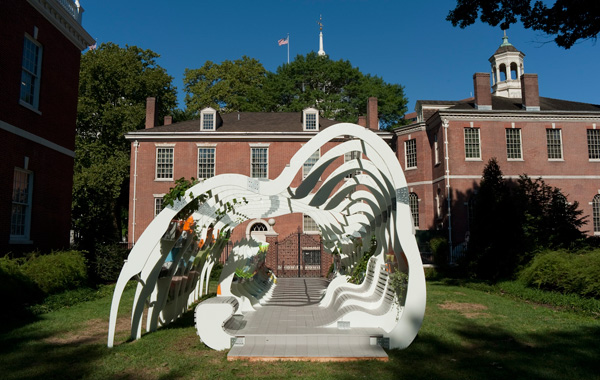 story by julie lorchPeeking out between the colonial brick buildings on South 5th Street, a 52-foot, ribcage-like structure is a stranger amidst the relics of Old City. Neon orange, green and blue plastic panels, as well as plant life, stick out from all angles. The structure is a greenhouse and part of “The Greenhouse Projects,” a special exhibit at the American Philosophical Society (APS) Museum.
story by julie lorchPeeking out between the colonial brick buildings on South 5th Street, a 52-foot, ribcage-like structure is a stranger amidst the relics of Old City. Neon orange, green and blue plastic panels, as well as plant life, stick out from all angles. The structure is a greenhouse and part of “The Greenhouse Projects,” a special exhibit at the American Philosophical Society (APS) Museum.
“We invite artists to take historical materials, themes or objects from exhibitions and ask them to come up with something that will put a contemporary spin on the exhibitions,” says Dr. Sue Ann Prince, the director and curator at APS. The museum’s latest exhibition, “Of Elephants and Roses: Encounters with French and Natural History, 1790-1830,” is an exploration of natural history in post-revolutionary France. Philadelphia-based architectural designer Jenny Sabin, a 2010 Pew Fellow and professor in Design and Emerging Technologies at Cornell University, was invited to participate in the exhibit. The result: “The Greenhouse and Cabinet of Future Fossils,” an interactive, high-tech eco-structure.
When creating the greenhouse, Sabin considered how information about nature is disseminated to the public, both historically and in modern times. In the early 19th century, there was a shift in the way scientific research was conducted. “There was the scientist out in the field, collecting data and then all of a sudden,” says Sabin, “scientists began moving away from nature, becoming distanced. And there was the birth of the lab.” At the time the Jardin des Plantes, the main botanical garden in Paris, put scientists and their labs (or “cabinets”) on display.
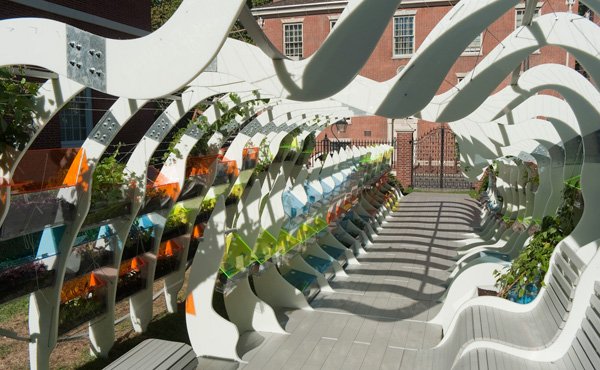 Sabin plays on this idea of the cabinet. Instead of putting nature behind glass, she reverses the enclosed geometry of the scientist in the lab, designing a structure that allows plants to flow into the urban fabric. Inspired by a series of mathematical studies of unraveling knots, Sabin created a canopy of 25 undulating white ribs through which visitors can walk and peek inside 110 colorful snap-fit coldframes, an age old gardening technique to grow food and plants in a fluctuating climate. These multi-colored, box-like structures have lids, which can be raised and lowered depending on the outside temperature, and angled sides that maximize sun exposure.
Sabin plays on this idea of the cabinet. Instead of putting nature behind glass, she reverses the enclosed geometry of the scientist in the lab, designing a structure that allows plants to flow into the urban fabric. Inspired by a series of mathematical studies of unraveling knots, Sabin created a canopy of 25 undulating white ribs through which visitors can walk and peek inside 110 colorful snap-fit coldframes, an age old gardening technique to grow food and plants in a fluctuating climate. These multi-colored, box-like structures have lids, which can be raised and lowered depending on the outside temperature, and angled sides that maximize sun exposure.
Organic matter grows up and out of the greenhouse coldframes, blending interior and exterior spatial conditions, and granting easy access to nature. In the warm days of late September, the lids to the coldframes were open. But as the months progress, gardeners will start to close the lids to stabilize the internal temperature. Some of the coldframes hold “future fossils,” 3D printed items inspired by pods, cellular systems and mathematical flowers. Next to the organic matter, they display a kind of “synthetic organi-cism.”
To create the actual greenhouse Sabin developed a series of custom-designed algorithms that she entered into a 3D modeling program. It was a generative process, meaning she didn’t know what the form would look like when she began. Though the materials are either 100 percent recycled or recyclable, the greenhouse juxtaposes the natural with the man-made. “The entire thing is made out of plastic” says Sabin, “but it’s the synthetic quality against the plants that was of most interest to me.”
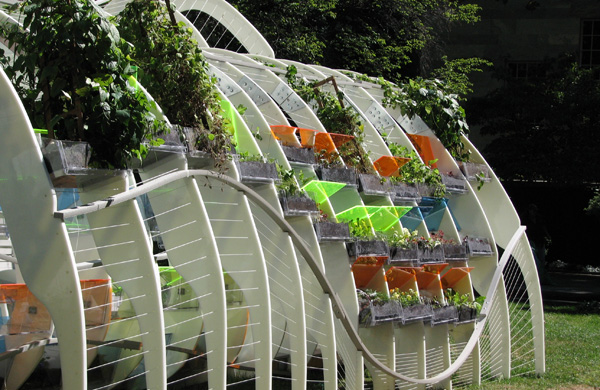 “Her work is really brilliant,” says Prince of Sabin’s greenhouse, which marks the the first collaboration between APS and an architect to construct a pavilion in the garden. “I view this as a work of art that’s also a greenhouse.”
“Her work is really brilliant,” says Prince of Sabin’s greenhouse, which marks the the first collaboration between APS and an architect to construct a pavilion in the garden. “I view this as a work of art that’s also a greenhouse.”
While the greenhouse is the main attraction, it isn’t just a visual project. A sound installation composed by Kyle Bartlett, another artist commissioned by APS, plays in the greenhouse. It’s a combination of natural sounds and French Revolutionary melodies with Bartlett’s own electronic compositions. The structure also served as a backdrop for a play written by Aaron Cromie, performed during the Philly Fringe Festival. A podcast series and geocaching treasure hunt, which uses GPS technology, are also part of the exhibit.
In October, Sabin is giving a lecture on the greenhouse as part of DesignPhiladelphia and APS is hosting various “Greenhouse Project” workshops in association with the Pennsylvania Horticultural Society’s City Gardening Series. The workshops include a session on extending the growing season, planting herbs in containers,and growing in coldframes. This last workshop will teach visitors about coldframe technology, and could offer a chance to take home a piece of the exhibit. Sabin would like the greenhouse to travel, so distributing coldframes and creating new ones would all be part of the project. “The hope is to fab[ricate] a new set of cabinets before it reaches its next destination,” says Sabin, “so that the greenhouse develops a type of ‘urban tapestry.’”
For more information about “The Greenhouse Project” and details on events and hours, visit the museum’s website, www.apsmuseum.org.



